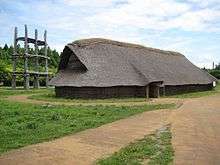Sannai-Maruyama site

Sannai-Maruyama site (三内丸山遺跡) is a Jōmon period archaeological site in Aomori, Aomori Prefecture, Japan. The site was discovered in 1992, when Aomori Prefecture started surveying a site for a planned baseball stadium. Archaeologists have used this site to further their understanding of the transition to sedentism and the life of the Jomon people. Excavation has led to the discovery of storage pits, above ground storage and long houses. These findings demonstrate a change in the structure of the community, architecture, and organizational behaviors of these people. Because of the extensive information and importance, this site was designated as a Special National Historical Site of Japan in 2000. Today the public can visit this site and its many reconstructions.
History



Sannai Maruyama was first settled around 3900 BCE. The first settlers on the site lived in pit houses. These dwellings typically were about 3–4 meters (9.8–13.1 ft) in diameter. Over 500 pit dwellings have been found on site. Additionally, they stored their food in underground pits, which allowed them to hide it when they left the site since the occupants were not yet living a sedentary lifestyle.
Around 2900 BC, the way the site occupants lived and stored food began to change. They began to store food above ground in buildings rather than underground in pits. This change happened as they became more sedentary. Also, long houses began showing up around this time. Long houses were large, oval-shaped structures. The longest one found at the site was 32 meters (105 feet) long. Scholars believe long houses were used for meeting places, workshops, or living space. Pit houses were still being inhabited at the same time that long houses existed on the landscape.
One of Sannai Maruyama’s most famous structures, the large six-pillared building, was built around 2,600 BC. This structure consisted of six large pillars that are believed to have held up platforms. Each one of these pillars was around 1 meter in diameter and was placed exactly 4.2 m (14 ft) apart. Due to its large size, it is believed that this structure functioned as a monument or watchtower. Remains of other six-pillared buildings from different time periods have been found throughout the site. Many of the post holes from these buildings overlap each other, which suggests that the structures were being rebuilt in the same location and facing the same direction.
The settlement of Sannai Maruyama ended around 2300 BCE.
The first major excavations of the site occurred in 1953 to 1967. These excavations involved teams from Keio University and the Board of Education of Aomori City. In 1976 and 1987, the Board of Education of Aomori Prefecture and Aomori City conducted further excavations on the southern part of the site.
A major breakthrough for the site came in 1992 while excavating during a pre-construction phase for a baseball stadium. This excavation uncovered how large Sannai Maruyama was as well as a large amount of artifacts. Excavations in June 1994 uncovered the large six-pillared building. Later that year it was announced that the site would be preserved and would live on as a historical site. After this was announced a number of the excavations were backfilled to protect the site.
Since 1994, around 26 additional test excavations have been done. These excavations have resulted in around 40% of the site being excavated.
Interpretation
The site Sannai Maruyama was inhabited by hunter-gatherers around the time frame 3900 BC – 2900 BC. Over this period of time, the site changed from a seasonal camp, to the home of a more mobile society, and finally to a settled village. Evidence of this sedentary lifestyle can be found in the form of intense use of natural resources such as nuts, fish, and a wide diversity of plants, as well as changes in storage facilities.
Initially, the site was used as a temporary site. There were large pits used for storage and can be concealed since they were underground, which was preferred by mobile populations in many parts of the world. At Sannai Maruyama, the storage features changed from these underground pits to elevated granaries around 2900 BC. One interpretation of this change was that the once mobile group of inhabitants had become sedentary.
Later in the site, we see longhouses that were built along with some pit houses at the site. The increase in housing also shows a more sedentary lifestyle (along with an increase in population). Also, there appeared to be several large posts that seemed to form a platform. This huge post shows a coordinated labor force since the sheer size of these posts would have required cooperation of several people to make. One interpretation of this large post like platform is that it was a base for a tower, or even a shrine.
See also
References
- Shibuya, Tomoko. "Sannai-Maruyama excavation illuminating Jomon life" The Japan Times 6 October 1997. Retrieved 12 November 2008.
- Habu, Junko. "Growth and decline in complex hunter-gatherer societies: a case study from the Jomon period" Sannai Maruyama site, Japan.
- Sannai-Maruyama. "The Sannai Maruyama Site." Sannai Maruyama. Sannai-Maruyama Site Preservation Office. Web. 7 December 2011.
External links
| Wikimedia Commons has media related to Sannai Maruyama Site. |
- Official website (Japanese)
- Official website (English)
- "Sannai Maruyama." Jomon Archaeological Sites. Retrieved 28 July 2016.
- "Sannai Maruyama excavation report" The Comprehensive Database of Archaeological Site Reports in Japan.
Coordinates: 40°48′42″N 140°41′44″E / 40.81167°N 140.69556°E